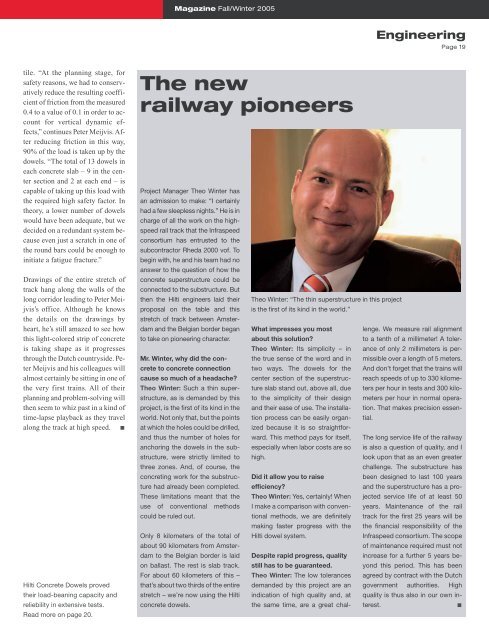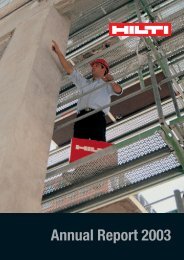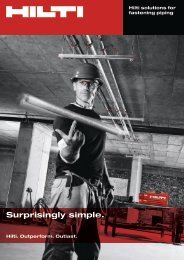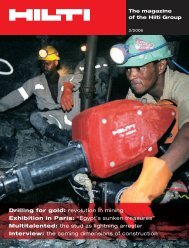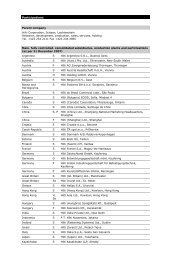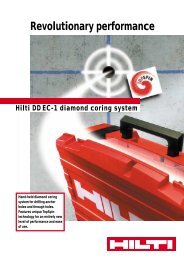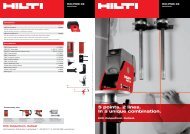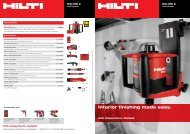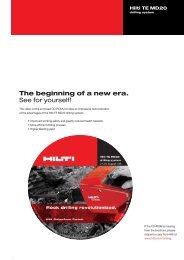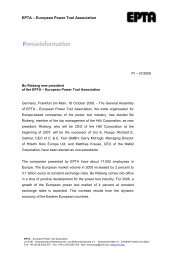Netherlands: high-tech fastening for high-speed track ... - Hilti
Netherlands: high-tech fastening for high-speed track ... - Hilti
Netherlands: high-tech fastening for high-speed track ... - Hilti
You also want an ePaper? Increase the reach of your titles
YUMPU automatically turns print PDFs into web optimized ePapers that Google loves.
Magazine Fall/Winter 2005<br />
Engineering<br />
Page 19<br />
tile. “At the planning stage, <strong>for</strong><br />
safety reasons, we had to conservatively<br />
reduce the resulting coefficient<br />
of friction from the measured<br />
0.4 to a value of 0.1 in order to account<br />
<strong>for</strong> vertical dynamic effects,”<br />
continues Peter Meijvis. After<br />
reducing friction in this way,<br />
90% of the load is taken up by the<br />
dowels. “The total of 13 dowels in<br />
each concrete slab – 9 in the center<br />
section and 2 at each end – is<br />
capable of taking up this load with<br />
the required <strong>high</strong> safety factor. In<br />
theory, a lower number of dowels<br />
would have been adequate, but we<br />
decided on a redundant system because<br />
even just a scratch in one of<br />
the round bars could be enough to<br />
initiate a fatigue fracture.”<br />
Drawings of the entire stretch of<br />
<strong>track</strong> hang along the walls of the<br />
long corridor leading to Peter Meijvis’s<br />
office. Although he knows<br />
the details on the drawings by<br />
heart, he’s still amazed to see how<br />
this light-colored strip of concrete<br />
is taking shape as it progresses<br />
through the Dutch countryside. Peter<br />
Meijvis and his colleagues will<br />
almost certainly be sitting in one of<br />
the very first trains. All of their<br />
planning and problem-solving will<br />
then seem to whiz past in a kind of<br />
time-lapse playback as they travel<br />
along the <strong>track</strong> at <strong>high</strong> <strong>speed</strong>.<br />
<strong>Hilti</strong> Concrete Dowels proved<br />
their load-beaning capacity and<br />
reliebility in extensive tests.<br />
Read more on page 20.<br />
The new<br />
railway pioneers<br />
Project Manager Theo Winter has<br />
an admission to make: “I certainly<br />
had a few sleepless nights.” He is in<br />
charge of all the work on the <strong>high</strong><strong>speed</strong><br />
rail <strong>track</strong> that the Infra<strong>speed</strong><br />
consortium has entrusted to the<br />
subcontractor Rheda 2000 vof. To<br />
begin with, he and his team had no<br />
answer to the question of how the<br />
concrete superstructure could be<br />
connected to the substructure. But<br />
then the <strong>Hilti</strong> engineers laid their<br />
proposal on the table and this<br />
stretch of <strong>track</strong> between Amsterdam<br />
and the Belgian border began<br />
to take on pioneering character.<br />
Mr. Winter, why did the concrete<br />
to concrete connection<br />
cause so much of a headache?<br />
Theo Winter: Such a thin superstructure,<br />
as is demanded by this<br />
project, is the first of its kind in the<br />
world. Not only that, but the points<br />
at which the holes could be drilled,<br />
and thus the number of holes <strong>for</strong><br />
anchoring the dowels in the substructure,<br />
were strictly limited to<br />
three zones. And, of course, the<br />
concreting work <strong>for</strong> the substructure<br />
had already been completed.<br />
These limitations meant that the<br />
use of conventional methods<br />
could be ruled out.<br />
Only 8 kilometers of the total of<br />
about 90 kilometers from Amsterdam<br />
to the Belgian border is laid<br />
on ballast. The rest is slab <strong>track</strong>.<br />
For about 60 kilometers of this –<br />
that’s about two thirds of the entire<br />
stretch – we’re now using the <strong>Hilti</strong><br />
concrete dowels.<br />
Theo Winter: “The thin superstructure in this project<br />
is the first of its kind in the world.”<br />
What impresses you most<br />
about this solution?<br />
Theo Winter: Its simplicity – in<br />
the true sense of the word and in<br />
two ways. The dowels <strong>for</strong> the<br />
center section of the superstructure<br />
slab stand out, above all, due<br />
to the simplicity of their design<br />
and their ease of use. The installation<br />
process can be easily organized<br />
because it is so straight<strong>for</strong>ward.<br />
This method pays <strong>for</strong> itself,<br />
especially when labor costs are so<br />
<strong>high</strong>.<br />
Did it allow you to raise<br />
efficiency?<br />
Theo Winter: Yes, certainly! When<br />
I make a comparison with conventional<br />
methods, we are definitely<br />
making faster progress with the<br />
<strong>Hilti</strong> dowel system.<br />
Despite rapid progress, quality<br />
still has to be guaranteed.<br />
Theo Winter: The low tolerances<br />
demanded by this project are an<br />
indication of <strong>high</strong> quality and, at<br />
the same time, are a great challenge.<br />
We measure rail alignment<br />
to a tenth of a millimeter! A tolerance<br />
of only 2 millimeters is permissible<br />
over a length of 5 meters.<br />
And don’t <strong>for</strong>get that the trains will<br />
reach <strong>speed</strong>s of up to 330 kilometers<br />
per hour in tests and 300 kilometers<br />
per hour in normal operation.<br />
That makes precision essential.<br />
The long service life of the railway<br />
is also a question of quality, and I<br />
look upon that as an even greater<br />
challenge. The substructure has<br />
been designed to last 100 years<br />
and the superstructure has a projected<br />
service life of at least 50<br />
years. Maintenance of the rail<br />
<strong>track</strong> <strong>for</strong> the first 25 years will be<br />
the financial responsibility of the<br />
Infra<strong>speed</strong> consortium. The scope<br />
of maintenance required must not<br />
increase <strong>for</strong> a further 5 years beyond<br />
this period. This has been<br />
agreed by contract with the Dutch<br />
government authorities. High<br />
quality is thus also in our own interest.


